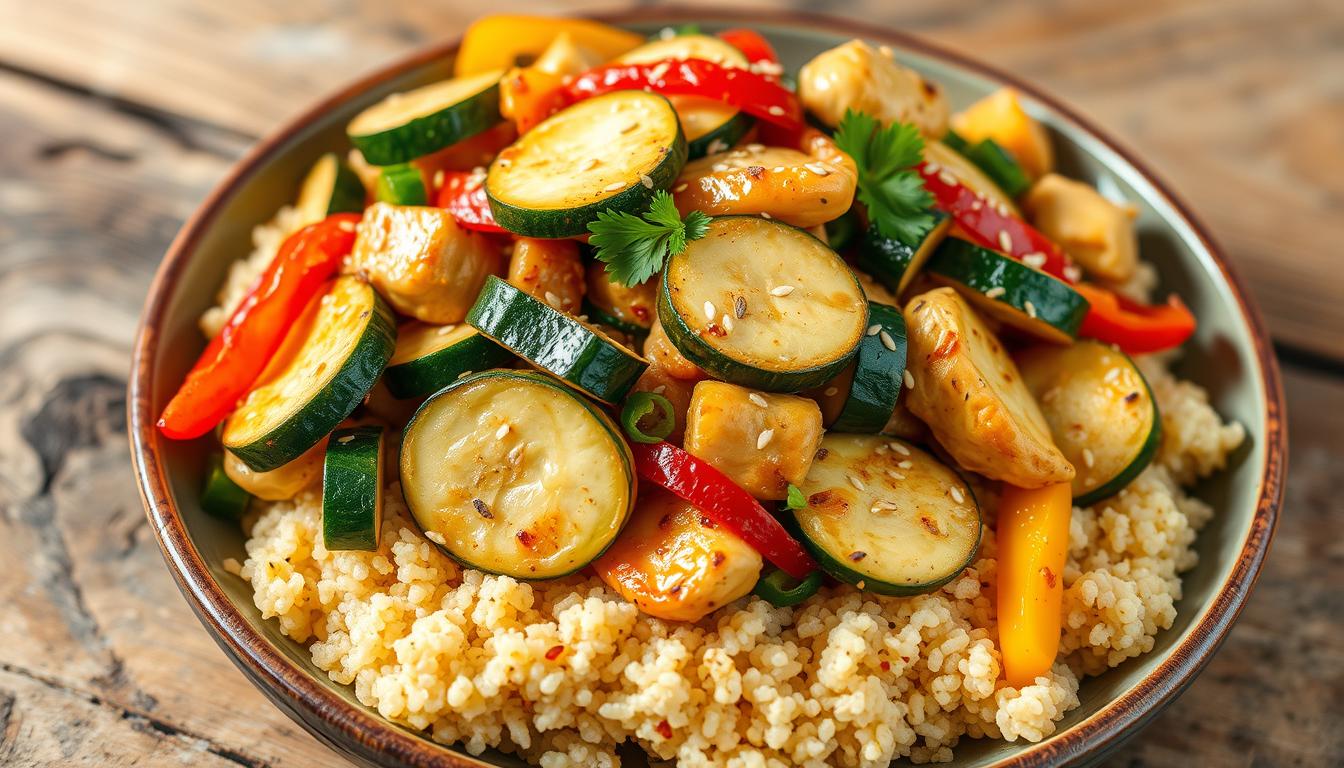Are you living with fibromyalgia and looking for a tasty, healthy meal? This chicken zucchini stir-fry with quinoa is your answer. Studies show that diet is key in managing fibromyalgia. Five out of seven trials found diet helped with pain and function.
A low FODMAP diet can cut gastric pain and intestinal issues by 50% in fibromyalgia patients. This meal is packed with lean protein, veggies, and quinoa. It’s anti-inflammatory and full of nutrients to help manage your symptoms.
Fibromyalgia: Understanding the Complexities
Fibromyalgia (FM) is more than just pain and tiredness. It affects a person’s life in many ways, touching their body, mind, and feelings. Knowing about fibromyalgia helps find better ways to manage it and improve life for those with it.
Fibromyalgia Symptoms and Impact on Daily Life
People with fibromyalgia face many symptoms. These include chronic pain, overwhelming fatigue, sleep problems, brain fog, and stomach issues. These symptoms make everyday tasks hard, affecting work, social life, and physical activities. The changing nature of symptoms adds to the frustration and uncertainty.
The Quest for Effective Management Strategies
Doctors and researchers are always looking for ways to help fibromyalgia. They try different treatments and lifestyle changes, like diet. Finding the right treatment is key to helping people with fibromyalgia.
By looking at all aspects of fibromyalgia and trying different approaches, people can find what works best for them. This helps them manage their symptoms and live better.
The Role of Diet in Fibromyalgia Management
Recent studies have shown that certain diets can help manage fibromyalgia symptoms. They looked at diets like gluten-free, raw vegetarian, and low-FODMAP. These diets can improve pain, fatigue, sleep, and overall health.
Dietary Interventions: Recent Research Findings
Research shows that diet can be key in managing fibromyalgia. For example, a study on Worryhead.com found that a low-FODMAP diet helps with gut issues and other symptoms. Another study on the Leaky Gut Diet found it can reduce inflammation and improve well-being.
Gluten-free, raw vegetarian, and hypocaloric diets also show promise. They help manage fibromyalgia symptoms, improving life quality for those affected.
| Dietary Intervention | Key Findings |
|---|---|
| Gluten-free diet | Reduced pain, fatigue, and gastrointestinal symptoms |
| Raw vegetarian diet | Improved sleep quality and reduced inflammation |
| Low-FODMAP diet | Alleviated gastrointestinal distress and other fibromyalgia-related symptoms |
| Hypocaloric diet | Decreased pain and improved overall well-being |
| MSG- and aspartame-free diet | Reduced pain, fatigue, and cognitive impairment |
Dietary interventions offer hope for managing fibromyalgia. By focusing on specific diets, people with fibromyalgia can find relief and better quality of life.
Chicken Zucchini Stir-Fry with Quinoa for Fibromyalgia
If you have fibromyalgia, try this chicken zucchini stir-fry with quinoa. It’s a great choice because it has lean protein, veggies, and gluten-free quinoa. This mix makes a meal that fights inflammation and helps with fibromyalgia symptoms.
This recipe is full of vitamins, minerals, and antioxidants. It’s made to help your body deal with fibromyalgia’s challenges. The main ingredients are:
- Chicken – a lean protein that helps muscles recover
- Zucchini – a low-FODMAP veggie with lots of fiber and anti-inflammatory stuff
- Quinoa – a gluten-free, high-protein food that keeps blood sugar stable
These ingredients work together to boost your health. They might help reduce fibromyalgia symptoms like muscle pain, tiredness, and stomach issues.
Making this recipe takes about 30 minutes to prepare and 30 minutes to cook. It makes 5 servings. This means you can have a tasty, healthy meal ready for you any day of the week.
Adding this chicken zucchini stir-fry with quinoa to your diet is a big step towards managing fibromyalgia. It’s a delicious, nutritious meal that can help you feel better. Enjoy this meal as part of your journey to better health and happiness.
Benefits of a Nutrient-Dense, Anti-Inflammatory Meal
Living with fibromyalgia can be tough. But, a diet rich in nutrients and anti-inflammatory foods can make a big difference. The chicken zucchini stir-fry with quinoa is packed with what your body needs to fight inflammation and stay healthy.
Quinoa is a superfood that’s gluten-free and has all the amino acids your body needs. It’s also full of fiber, minerals, and B vitamins. These nutrients are key in managing fibromyalgia symptoms. Chicken breast is lean and high in quality protein, helping your muscles recover and grow.
The veggies in this dish, like zucchini, are loaded with anti-inflammatory compounds and antioxidants. These help fight the chronic inflammation that often comes with fibromyalgia. This can lead to less pain and better overall health.
| Nutrient | Benefit for Fibromyalgia |
|---|---|
| Protein | Supports muscle recovery and repair |
| Fiber | Promotes gut health and regularity |
| Antioxidants | Reduce inflammation and oxidative stress |
| B Vitamins | Help convert food into energy |
Adding this nutrient-dense, anti-inflammatory meal to your diet can nourish your body. It might help ease some of the tough symptoms of fibromyalgia. A mix of good nutrition, exercise, and managing stress is key to managing this chronic condition.
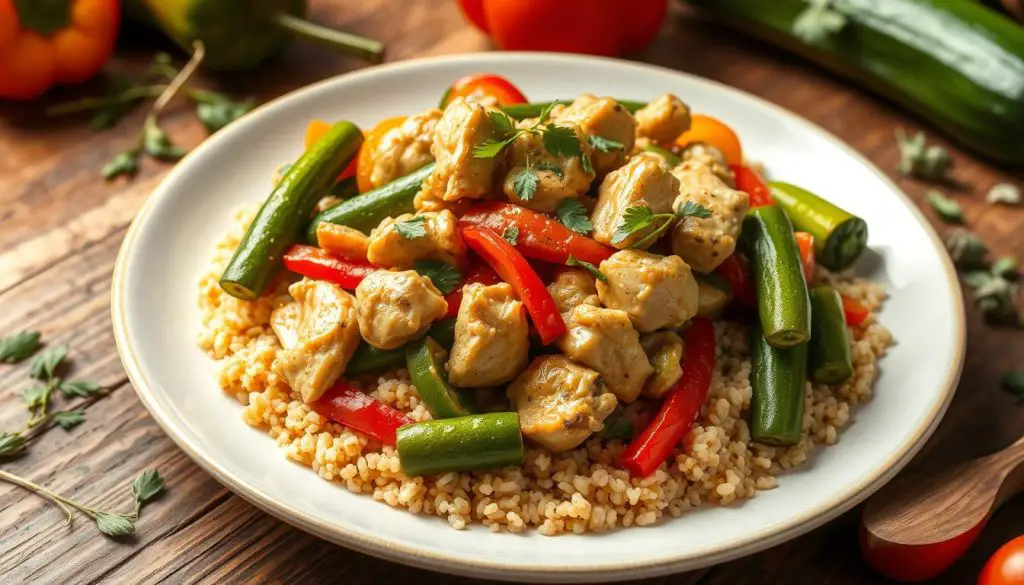
Low-FODMAP Cooking: Easing Gastrointestinal Distress
If you have fibromyalgia, you face many challenges, including digestive issues. The low-FODMAP diet can help ease these problems. It can improve your overall health and well-being.
FODMAPs are carbs that can upset your stomach, affecting those with fibromyalgia. A low-FODMAP diet reduces your exposure to these carbs. This can help soothe your gastrointestinal symptoms in fibromyalgia.
The chicken zucchini stir-fry with quinoa recipe is low in FODMAPs. It’s perfect for those with fibromyalgia. Here’s how it can help your digestive issues:
- Zucchini is a low-FODMAP veggie. It’s full of fiber and nutrients without causing stomach problems.
- Quinoa is gluten-free and high in protein. It’s also low in FODMAPs, making it good for your diet.
- The recipe doesn’t include onions and garlic. These can make gastrointestinal symptoms in fibromyalgia worse.
Adding low-FODMAP foods to your meals can help manage fibromyalgia symptoms. Try this recipe and other low-FODMAP dishes. Find what works best for your body and health needs.
Quinoa: A Gluten-Free, High-Protein Superfood
For those with fibromyalgia, adding quinoa to their meals can be a big help. This grain is gluten-free and packed with protein. It’s also full of nutrients that can ease fibromyalgia symptoms.
Nutritional Profile and Health Benefits of Quinoa
Quinoa is loaded with fiber, vitamins, and minerals. It’s a top choice for those with fibromyalgia because it’s high in protein. It has all the amino acids needed, making it a great protein source without gluten.
Research shows that quinoa is rich in magnesium and fiber. These are key for managing fibromyalgia symptoms. The fiber in quinoa can also help prevent constipation, a common problem for those with the condition.
Quinoa is also a superfood because of its high antioxidant content. These antioxidants help fight inflammation. Inflammation is a big part of managing fibromyalgia.
| Nutrient | Amount in 1 cup of Cooked Quinoa |
|---|---|
| Protein | 8 grams |
| Fiber | 5.2 grams |
| Magnesium | 118 milligrams |
| Folate | 19.8 micrograms |
| Iron | 2.8 milligrams |
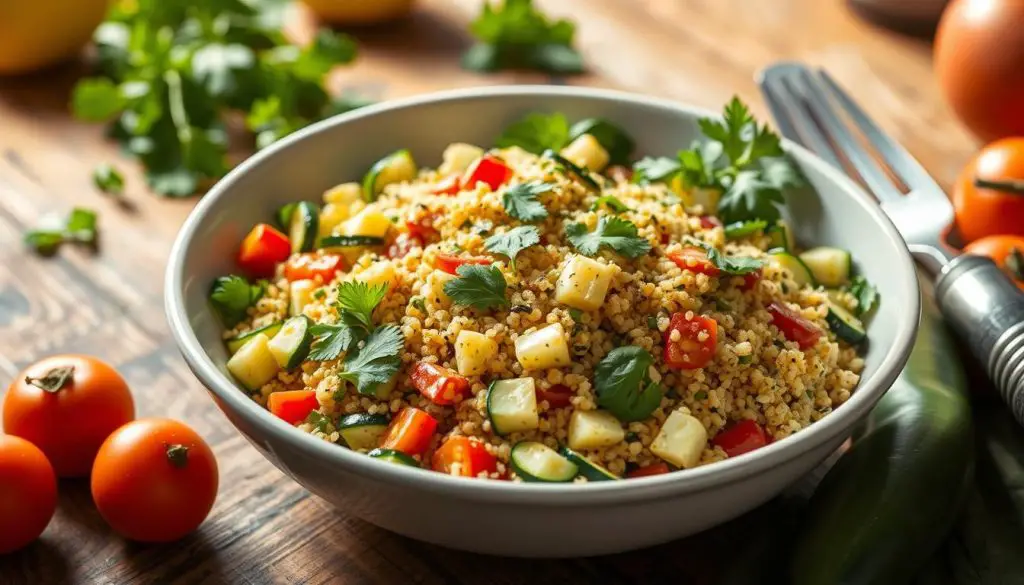
Adding quinoa, a gluten-free, high-protein superfood, to your diet can boost energy. It supports overall health and helps manage fibromyalgia symptoms.
Zucchini: A Versatile, Fibromyalgia-Friendly Vegetable
If you have fibromyalgia, adding low-FODMAP veggies to your diet can really help. Zucchini is a great choice. It’s easy to cook and packed with health benefits.
Zucchini is easy on the stomach, which is good for fibromyalgia sufferers. It tastes mild and can be used in many dishes. This makes it perfect for those with fibromyalgia.
Zucchini is full of vitamins and minerals. It has lots of Vitamin C, B6, manganese, and potassium. These nutrients are important for staying healthy. Plus, it has antioxidants that fight inflammation, a big problem for people with fibromyalgia.
Adding zucchini to your meals can really help your body. You can eat it raw, sautéed, roasted, or as a low-carb pasta substitute. It’s a great way to make your diet better and ease fibromyalgia symptoms.
Incorporating Lean Protein into Your Fibromyalgia Diet
Eating a balanced diet is key for managing fibromyalgia symptoms. Adding lean protein sources, like chicken, is important. These proteins help with muscle function, reduce inflammation, and give lasting energy. All these benefits are vital for those with fibromyalgia.
Choosing Lean Protein Sources for Fibromyalgia
When picking proteins for your diet, choose lean ones that are low in fat and rich in nutrients. Good options include:
- Chicken breast
- Turkey breast
- Lean ground turkey
- Tuna or salmon (wild-caught)
- Legumes (e.g., lentils, chickpeas, black beans)
- Tofu or tempeh (for vegetarian/vegan options)
The Wild Diet promotes a high-protein diet with whole foods. This can be good for fibromyalgia. Adding lean protein for fibromyalgia and other nutrients can improve your health and manage fibromyalgia’s challenges.
| Lean Protein Source | Nutrients | Benefits for Fibromyalgia |
|---|---|---|
| Chicken Breast | High in protein, low in fat, rich in B vitamins, and a good source of selenium | Supports muscle function, reduces inflammation, and provides sustained energy |
| Salmon | High in protein, omega-3 fatty acids, and vitamin D | Helps reduce inflammation and supports overall immune function |
| Lentils | High in protein, fiber, and complex carbohydrates, as well as various vitamins and minerals | Provides a sustainable energy source and supports digestive health |
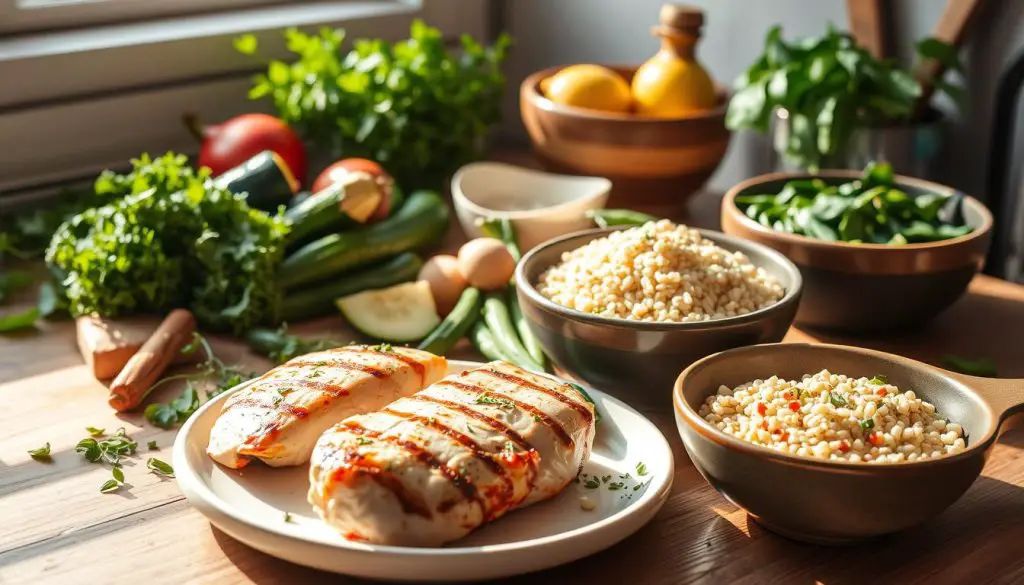
By eating a high-protein diet for fibromyalgia with these lean proteins, you fuel your body. This helps manage fibromyalgia’s challenges. Always talk to your healthcare provider or a dietitian for advice on your diet.
Tips for Meal Prepping and Batch Cooking
Meal prepping and batch cooking can really help those with fibromyalgia. Spend a few hours on the weekend or when you’re feeling better. This way, you can make healthy meals for the week ahead. It saves time and energy when you’re tired or in pain.
Here are some tips for meal prepping and batch cooking with fibromyalgia:
- Choose simple recipes like the chicken zucchini stir-fry with quinoa. It’s great for batch cooking because it reheats well.
- Look for meals that are full of nutrients, fight inflammation, and are easy to digest. Think lean proteins, complex carbs, and veggies.
- Get good storage containers to keep your meals fresh and tasty all week.
- Try different cooking methods like roasting, steaming, or slow-cooking. It adds variety to your meals.
- Make batch cooking a regular part of your week. Set aside time on the weekend or a specific day to prep your meals.
By using meal prepping and batch cooking, you can manage your fibromyalgia better. You’ll have nourishing meals that help ease your symptoms and support your health.
Customizing the Recipe to Your Dietary Needs
The chicken zucchini stir-fry with quinoa recipe can be tailored for different diets. It works for those on a gluten-free or vegetarian diet. You can make it fit your needs.
Gluten-Free and Vegetarian Adaptations
For those with gluten issues, use gluten-free soy sauce or tamari. Vegetarians can swap chicken for tofu or a plant-based protein. This makes it vegetarian-friendly.
| Dietary Need | Customization |
|---|---|
| Gluten-Free | Use gluten-free soy sauce or tamari |
| Vegetarian | Substitute chicken with tofu or a plant-based protein |
With these easy changes, you can enjoy the tasty customizable fibromyalgia recipes. They meet your gluten-free or vegetarian needs.
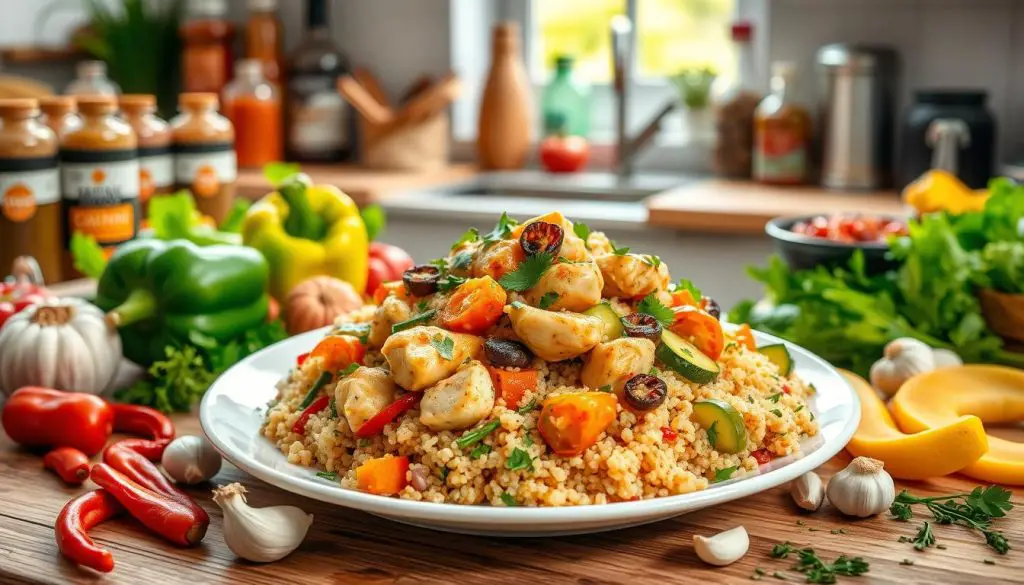
Pairing Your Chicken Zucchini Stir-Fry with Quinoa
Finding the right mix of nutrients and flavors is important for managing fibromyalgia. Your tasty pairing fibromyalgia recipes, like the Chicken Zucchini Stir-Fry with Quinoa, can be made even better with the right side dishes. These not only look good but also add more nutrients to your meal. This helps meet the varied needs of those with this condition.
One easy and tasty option is to serve the stir-fry on top of fresh, crisp greens like a green salad. The warm stir-fry and cool salad make a great mix of textures and temperatures. This makes for a well-rounded and balanced meal.
For more fiber and vitamins, try pairing it with roasted veggies. Zucchini, bell peppers, and asparagus are great side dishes for fibromyalgia. They’re full of antioxidants and anti-inflammatory compounds that can ease symptoms.
| Pairing Options | Benefits |
|---|---|
| Fresh Green Salad | Provides a crisp, crunchy contrast to the warm stir-fry; adds additional nutrients and fiber. |
| Roasted Vegetables | Boosts fiber, vitamins, and antioxidants; complements the flavors of the stir-fry. |
| Steamed Broccoli | Offers a nutrient-dense, anti-inflammatory side that pairs well with the protein-rich stir-fry. |
By carefully choosing what to pair with your Chicken Zucchini Stir-Fry with Quinoa, you can make a meal that’s both nourishing and enjoyable. Try out different pairing fibromyalgia recipes and side dishes to find what works best for you.
Mindful Eating and Reducing Stress
When you enjoy your chicken zucchini stir-fry with quinoa, take a moment to practice mindful eating. Savor each bite, enjoying the flavors and textures. Mindful eating helps you connect with your food, leading to calm and well-being. These are key for managing fibromyalgia symptoms.
Adding stress-reducing techniques to your routine is also helpful for stress management for fibromyalgia. Try deep breathing or gentle stretching while you eat. This helps you slow down and feel more in control of your symptoms.
The path to better mindful eating for fibromyalgia is ongoing. Be patient and celebrate small wins. With a mindful and stress-aware approach, you can find balance and resilience in your life.
Seeking Professional Guidance and Support
Working with healthcare providers for fibromyalgia is key to managing symptoms. Doctors, nutritionists, or registered dietitians can help create a personalized plan. They guide on diet, medication, and treatments for the best results.
Team up with healthcare providers for fibromyalgia to tackle fibromyalgia challenges. They’ll do medical checks, suggest meds or supplements, and make a meal plan just for you.
Building a strong support network is also vital. Join support for individuals with fibromyalgia groups or online forums. These offer friendship, emotional support, and advice from those who get it. Sharing your story and learning from others can really help.
Managing fibromyalgia is a team effort. With your healthcare providers for fibromyalgia and a supportive group, you can improve your life and well-being.
| Resources for Fibromyalgia Support | Description |
|---|---|
| Fibromyalgia Action UK | A UK-based charity providing support, information, and resources for individuals living with fibromyalgia. |
| Fibromyalgia Support Group | An online community providing peer support, forums, and educational materials. |
| American Chronic Pain Association | A non-profit giving support and resources for those with chronic pain, including fibromyalgia. |
Inspiring Fibromyalgia-Friendly Recipe Ideas
The chicken zucchini stir-fry with quinoa is just one example of fibromyalgia-friendly recipes you can try. There are many anti-inflammatory, nutrient-dense meals to explore. These can help manage fibromyalgia symptoms.
Try hearty lentil soups, creamy pumpkin alfredo over zucchini noodles, or bison chili. Flaxseed muffins are also great, full of prebiotic fibers. There are endless options to nourish your body and reduce inflammation.
Everyone’s needs and preferences are different. Feel free to experiment and adjust recipes to fit your dietary needs. With creativity and whole, nutrient-rich ingredients, you can make delicious meals. These will help you feel energized and empowered on your health journey.
Source Links
- https://www.paincation.com/seeking-relief-from-fibromyalgia-through-diet-a-hopeful-path-in-a-sea-of-doubts-rss/
- https://www.living-smarter-with-fibromyalgia.com/gluten-free.html
- https://rawlsmd.com/health-articles/how-to-make-cooking-with-a-chronic-illness-easier
- https://www.theairdiet.com/blog
- https://dokumen.pub/cfids-fibromyalgia-and-the-virus-allergy-link-hidden-viruses-allergies-and-uncommon-fatigue-pain-disorders-0789010739-9780789010735.html
- https://wellnessmama.com/health/autoimmune-diet/comment-page-1/
- https://www.healthline.com/nutrition/ornish-diet-review
- https://awellness.com/index.php/healthy-food-choices/
- https://livingwithfibro-guaiprotocol.com/hg-diet-and-meal-ideas
- https://liveandeatclean.com/asian-stir-fry-with-chicken/
- https://www.healthline.com/nutrition/healthy-dinner-ideas-for-two
- https://www.bjchealth.com.au/diet/all
- https://threestonehearth.com/everything
- https://itsafodmaplife.wordpress.com/
- https://www.epbot.com/2017/07/every-single-night.html
- https://www.healthline.com/nutrition/50-super-healthy-foods
- https://www.healthline.com/nutrition/hypothyroidism-diet
- https://www.verywellhealth.com/leaky-gut-diet-4773680
- https://inspiralized.com/romesco-garlic-shrimp-with-zucchini-noodles/
- https://www.healthline.com/health/food-nutrition/19-high-protein-vegetables
- https://www.julienutrition.com/introduce-vegetables-diet/
- https://restormedicine.com/wp-content/uploads/woocommerce_uploads/2023/06/ebook-dbjlbc.pdf
- https://www.raptitude.com/2011/03/what-i-discovered-when-i-went-vegan-for-30-days/comment-page-1/
- https://www.marylandsportsinjurycenter.com/news.html
- https://www.healthline.com/nutrition/healthy-lunch-ideas-for-weight-loss
- https://www.aol.com/17-quick-easy-meals-dietitians-161549964.html
- https://nourishingmeals.com/search?updated-max=2014-11-14T10:58:00-08:00&max-results=6&reverse-paginate=true&m=1&search=&page=33
- https://www.healthline.com/nutrition/easy-healthy-meals
- https://dailymom.com/nest/10-healthy-recipes-high-in-protein/
- https://www.throughthefibrofog.com/air-fryer-stuffed-chicken/
- https://www.fischerfamilychiro.com/healthy-recipes.html
- http://caseythecollegeceliac.blogspot.com/2017/04/ultimate-snack-plate-gluten-free-vegan-recipe.html
- https://www.healthline.com/nutrition/candida-diet
- https://www.d-signednutrition.com/wp-content/uploads/2017/06/Mini-Nutrients-for-Maximum-Health-Dee-Harris-4.20.17.pdf
- https://www.throughthefibrofog.com/turmeric-chicken-soup/
- https://www.mobeforlife.com/resources
- https://www.healthline.com/nutrition/staple-foods-to-make-healthy-eating-easy-all-week-long
- https://www.throughthefibrofog.com/rosemary-chicken-fillets-with-turmeric/
